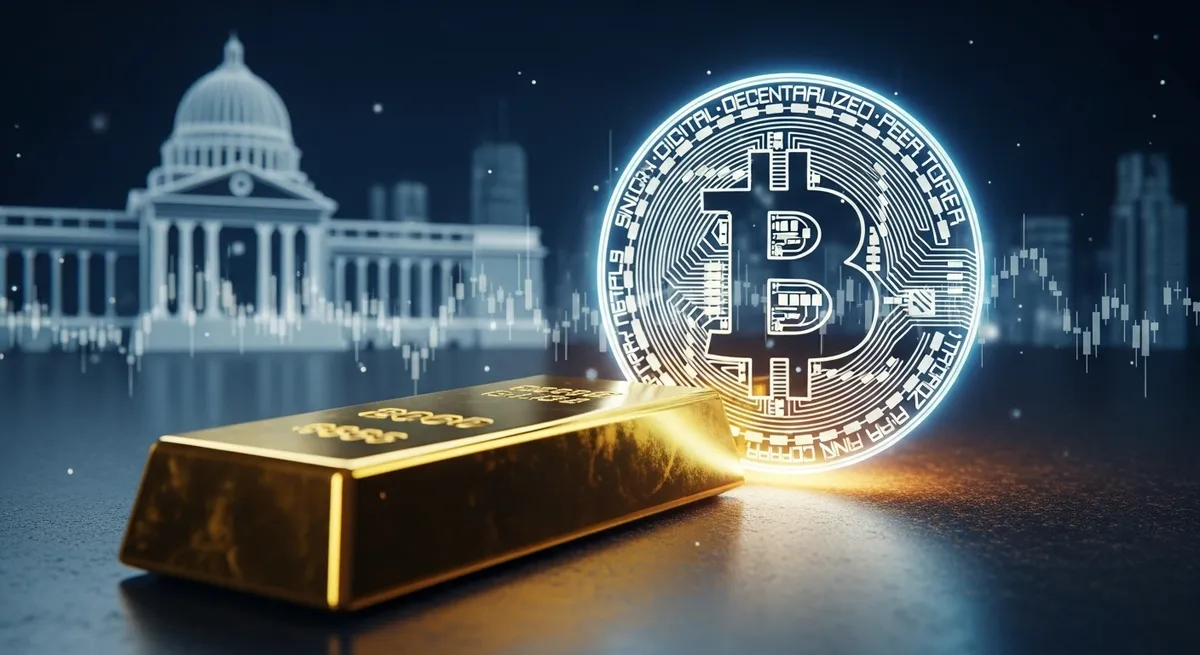
Bitcoin & Gold: Central Banks’ 2030 Target?
A historic shift is reshaping the global financial landscape: the potential for Bitcoin and gold to coexist on central bank balance sheets by 2030. This ambitious forecast comes from a Deutsche Bank report, highlighting Bitcoin's growing role as a reserve asset, particularly driven by leading adoption from the United States.
Deutsche Bank's Forecast: Bitcoin & Gold Coexistence
Deutsche Bank analysts Marion Laboure and Camilla Siazon state that "there is room for both gold and Bitcoin to coexist on central bank balance sheets by 2030." This prediction is not mere speculation but is based on strong macroeconomic trends and Bitcoin's increasing maturity.
Deutsche Bank believes that a strategic Bitcoin allocation could emerge as a modern foundation of financial security, echoing gold's role in the 20th century.
Factors Driving This Shift
Global Reserve Diversification Trend: The US dollar is gradually losing its unchallenged dominance. Its share in global reserves has dropped from 60% to approximately 43% by 2024, reflecting a "de-dollarization" trend as nations, especially emerging markets and BRICS countries, seek to reduce reliance on the USD due to concerns over sanctions and US fiscal policies.
Inflation Hedging and Geopolitical Risk: Amid economic and geopolitical instability, both gold and Bitcoin are seen as effective hedges against inflation, geopolitical risks, and questions regarding monetary sovereignty. They offer stability and value preservation for investors and central banks alike.
Bitcoin's Increasingly Gold-Like Characteristics: The Deutsche Bank report specifically emphasizes Bitcoin's maturation. Its price volatility has significantly decreased, even during record-breaking rallies, making it more stable and reliable, akin to gold.
Scarcity and Liquidity: Like gold, Bitcoin has a fixed supply capped at 21 million units, offering deflationary benefits. Coupled with deeper liquidity and increasing adoption, this strengthens its role as a valuable asset.
Superior Portability and Accessibility: A significant advantage of Bitcoin over gold is its portability. The cost of storing large amounts of Bitcoin is virtually zero, making it an ideal reserve asset during times of conflict, contrasting with the logistical challenges and costs of moving physical tons of gold.
Institutional Acceptance: Major corporations like MicroStrategy accumulating Bitcoin on their balance sheets is also a clear indicator of changing perceptions and growing confidence in this asset.
Gold: The Proven Safe-Haven Asset
Gold has firmly cemented its position as the ultimate safe-haven asset, with prices surging to record highs in recent years (e.g., nearly $4,000/ounce by October 2025). Central banks are a primary driving force behind this trend.
A recent World Gold Council survey showed that 43% of monetary authorities plan to increase their gold reserves in the next 12 months, and nearly 95% expect global central bank gold reserves to continue rising.
Reasons Central Banks Buy Gold
Diversification and Risk Reduction: Gold provides stability for national currencies and diversification away from fiat currencies like the US dollar.
Inflation Protection: Historically, gold has performed well as an inflation hedge during periods of monetary expansion.
Public Confidence: Holding significant gold reserves helps boost public confidence in a nation's financial resilience.
Geopolitical Risks: Gold has regained prominence in central bank reserve portfolios as a means of payment and safe haven amid geopolitical instability.
In 2023, central banks purchased 1,037 tonnes of gold, the second-highest annual total on record, and this trend continued strongly into 2024.
Bitcoin in Central Bank Eyes: Skepticism and Shifting Views
Skepticism
Volatility: Bitcoin's volatile nature is a significant challenge, though Deutsche Bank notes this volatility is decreasing.
Lack of Intrinsic Value: Many argue that Bitcoin lacks intrinsic value, has no physical form, and is not backed by a government.
Regulatory Risks: The regulatory environment surrounding cryptocurrencies is still evolving, lacking clear, consistent frameworks, leading to legal and operational risks.
Monetary Policy Control: Bitcoin's decentralized nature challenges central banks' ability to manage economic stability through monetary policies.
Signs of Indirect Acceptance and Openness
Indirect Exposure: Some institutions are gaining indirect exposure to Bitcoin by purchasing shares of crypto-related companies.
Regulatory Developments: Regulatory developments in major markets, particularly the United States, are considered crucial. The US Federal Reserve has greenlighted traditional banks to engage in the crypto space, provided they manage risks properly.
Central Bank Digital Currencies (CBDCs): Central banks are exploring their own CBDCs to capture the advantages of digital money while maintaining state control, although CBDCs differ from Bitcoin in their centralized nature.
The U.S. Role in Bitcoin's Future
US presidential executive orders to establish a strategic Bitcoin reserve are seen as a significant step that could elevate Bitcoin to a role similar to gold in shaping global financial standards.
This suggests that the US could act as a "global role model" for cryptocurrency adoption, setting a precedent for other nations.
Conclusion: A Future of Coexistence
Deutsche Bank's report paints a picture of a future where both gold and Bitcoin will play complementary roles in central bank reserves by 2030. They will not compete but coexist to diversify portfolios and hedge against risks. Gold will maintain its leading position in official reserves, but Bitcoin is expected to expand within private and alternative reserves, gradually gaining official reserve asset status.
However, challenges related to regulation and volatility persist. Bitcoin is unlikely to replace the US dollar as the primary reserve asset or means of payment. Market maturation, regulatory clarity, and continued institutional acceptance will be key factors for this historic transformation.
The content above reflects the author’s personal views and does not represent any official position of Cobic News. The information provided is for informational purposes only and should not be considered as investment advice from Cobic News.